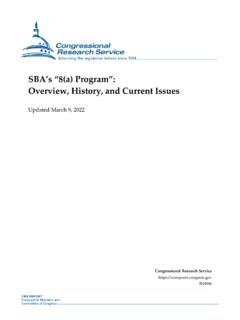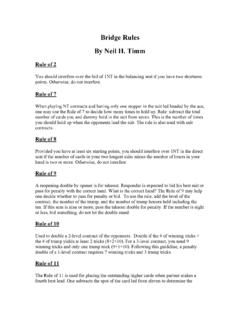Transcription of LIBRARY PLANNING - Howard University Home
1 LIBRARY PLANNING PLANNING is the deliberate, preferred manner of preparing for LIBRARY service in the future. It is the responsible means of fulfilling future community LIBRARY needs. A long-range plan, based on knowledge of the community, community expectations, resources of the community, and realistic projections of the future needs of the community will enable the LIBRARY trustees and administration to perform their responsibilities better by providing efficient and progressive LIBRARY service. Every LIBRARY shall develop, prepare and be guided by a long-range plan. ( PLANNING for LIBRARY Excellence Revised [Draft]) What Is A Plan? A summary of the current status of the LIBRARY . Look critically at what the LIBRARY does now. A plan is reality pushed into the future. By assessing the current situation, obvious needs and directions can be identified. Don t be afraid to brag about a good LIBRARY . An assessment of community needs.
2 A LIBRARY s first responsibility is to address the needs of its community. It is basic PLANNING to know what the community needs are. The American LIBRARY Association has developed a number of tools that can help identify useful statistics and statistical sources for understanding a LIBRARY s community. A statement of the LIBRARY s mission, goals, and objectives. Once the LIBRARY s overall role and mission are defined, specific goals with measurable objectives can be set. All decisions should be made in view of the plan. An ongoing process. PLANNING is an ongoing process. No plan is perfect. Unexpected events necessitate changes in any plan, and changing times present new problems and suggest new approaches to meeting LIBRARY goals. Unless some crisis requires immediate updating of the plan, the plan should be updated on an annual basis. PLANNING Tools The American LIBRARY Association has several useful PLANNING publications. Among the most important of these are: PLANNING and Role Setting in Public Libraries and Output Measures for Public Libraries, published in 1987.
3 They have been widely used by Virginia public libraries for strategic PLANNING . An important new publication of the American LIBRARY Association was recently (1998) issued in two parts: PLANNING for Results: A Public LIBRARY Transformation Process, which was designed to be a revised and updated edition of PLANNING and Role Setting. How Is A Plan Developed? There is no one best way to plan. PLANNING requires commitment, time, and organization. Preparation for PLANNING requires: Clarifying PLANNING purposes and methods. Defining responsibilities. Allocating resources to PLANNING . Establishing a PLANNING schedule. Gathering the information for PLANNING requires: Reviewing community needs for LIBRARY services including cultural, educational, and informational resources of the community. Looking at the demographic and economic data of the community. Identifying factors in the LIBRARY s environment that may affect the provision of services.
4 Analyzing the information allows: Understanding of the community needs for LIBRARY service. Realizing objectively what the community has and what the community lacks. Defining the LIBRARY s role in the community. Development of a LIBRARY s mission, goals, and objectives allows: Responsiveness to the community s needs, interests, and priorities. Prioritizing programs and directing efforts toward tasks leading to the attainment of the stated objectives. Evaluation of where your LIBRARY is in relation to the total plan. Remember that excellence in public LIBRARY service is not an idle dream. It is achieved daily by libraries matching LIBRARY services with community needs, interests, and priorities as identified through effective, thoughtful PLANNING . Benefits of a Plan Allows rational justification of your budget with governing authorities Helps you prioritize programs and direct efforts to attaining objectives Motivates the staff and board Encourages coordination and accountability Gives a clear measure for success Assures enough lead time to undertake projects effectively Leads to steady growth by encouraging yearly evaluation Recipe for a Plan A plan is a flexible document seasoned by specific local needs.
5 Most plans include the following: Description of the LIBRARY s service area and communities Summary of data supporting LIBRARY s needs Statement of general goals and specific objectives Details of services, programs, personnel, collection, and facilities desired Identification of priorities Timetable for achieving goals and objectives, both short- and long-range Cost projections for implementing the Plan Projections of resources Assignments and responsibilities for implementing the Plan Publicity campaign to accompany changes Provision for evaluation and reassessment at specific intervals WE PLANNED. HOW ARE WE DOING? The manual, PLANNING for LIBRARY Excellence, Revised (Draft), is an excellent resource for reviewing services and resources. Does the LIBRARY have a long-range plan on file at the LIBRARY of Virginia? Is the plan updated annually? Have procedures been drawn up for evaluating the plan? Is the responsibility for PLANNING clearly defined?
6 Are you familiar with and committed to your LIBRARY s long-range plan? PLANNING LIBRARY Buildings As trustees face the challenges of PLANNING LIBRARY services for the future, increased space and additional locations may become a major consideration. Governing boards must decide whether to build a new LIBRARY , renovate or expand current facilities, or find an existing space to be converted into a LIBRARY . Construction plans should be considered in the context of the total LIBRARY plan. Trustees need to study service needs, explore alternatives, project funding, and establish priorities. Most PLANNING processes will lead to the identification of a probable date when new LIBRARY space should be in operation. While having a new building may be the best answer, it is not always the most practical and should be measured against other options: purchase of an existing building, lease of an existing building, remodeling of the LIBRARY , addition to the LIBRARY , or in some cases, addition of branches.
7 Depending on the LIBRARY and its services, the addition of a bookmobile or other outreach techniques may be considered in expansion plans. At least every five years, each LIBRARY system will conduct a community analysis and LIBRARY -space-needs assessment. Utilization of the latest PLANNING tools, such as Output Measures for Public Libraries and Building Blocks for LIBRARY Space, is recommended. Space needs should be incorporated into the LIBRARY s PLANNING documents. ( PLANNING for LIBRARY Excellence, Revised [Draft]) Building Program After the LIBRARY has completed its community analysis, defined its long-term goals and objectives, and determined the need for additional space, a LIBRARY building program is developed. The building program defines the specific needs of the LIBRARY in both quantitative and qualitative terms. The building program should bring together the thinking of the LIBRARY board, the LIBRARY director, the LIBRARY staff, and the community on the purpose, scope, and function of the LIBRARY building program.
8 The building program should also stress that the building must be flexible and able to respond to future developments. LIBRARY functions and spaces should be able to expand and contract as needs develop or diminish. Existing and future technologies should be anticipated. Computerization, miniaturization, electronics, and other factors are already in play and will continue to develop. This has implications for the building s structure; its heating, ventilating, and air conditioning systems (HVAC); its power, lighting, electronic, and communications systems (PLEC), as well as the ergonomic needs in PLANNING spaces and equipment. Architect The architect should be hired only after a LIBRARY has completed these beginning steps of construction PLANNING . The architect can then use the LIBRARY building program in designing the building. Architectural services are covered under professional services in the Virginia State Procurement Act.
9 Therefore, a Request for Proposal (RFP) is issued for services. In hiring an architect, the LIBRARY should solicit applications, rank them by preference, and then enter into negotiations with the top choice, conducting personal interviews with the person or firm that interests the LIBRARY board. The past experience of the architect should be considered, as well as the architect s personal philosophy. Final fees should be discussed and agreement reached. If agreement cannot be reached with the first choice, the board then declares that is the case and enters negotiations with the next candidate. Design of the Building Once an architect is hired, the actual design of the building can proceed, along with final decisions on location, size, addition, or all new construction, etc. The general steps that will be followed are: Preparation of schematic design Preparation of preliminary plans and design development Preparation of specifications and working drawings Advertising and receipt of bids Bonding process Award of contracts Actual construction Acceptance of performance Move to new building PLANNING Responsibilities PLANNING for LIBRARY Excellence, Revised (Draft) should be consulted for building-related state standards and guidelines.
10 Trustees, staff members, consultants, architects, interior designers, city councils, county boards, jurisdictional staffs, regional PLANNING departments, and community members all fit into the picture. Trustees Determine that a new building is needed Provide leadership in the campaign to inform the community and secure necessary support for the project Appoint a building committee and assign tasks Select and hire LIBRARY building consultant Select and hire an architect Obtain financing for the project Select and purchase the site Approve the written building program Approve preliminary and final architectural plans Solicit and approve bid documents Approve all contracts and any change orders to the contract LIBRARY Staff The LIBRARY director and staff actively participate in PLANNING for construction projects by compiling information, surveys, and statistics; by helping to prepare a written building program; by preparing building applications and reports; and by maintaining project records.





